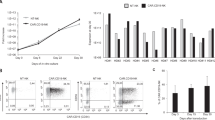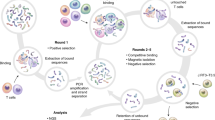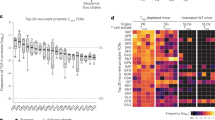Abstract
We have recently derived a series of cloned cell lines1 displaying natural killer (NK) cell-like activity from normal human fetal blood (25 weeks)2. The lines were obtained after repeated stimulation of mononuclear cells with allogeneic Epstein–Barr virus (EBV)-transformed B lymphocytes and are interleukin-2 (IL-2) dependent. Initial characterization of the clones has been reported previously1. Certain of these clones have been found to have unusual surface characteristics, namely, they are recognized by several well-defined anti-T3 antibodies, but do not react with WT31 (ref. 3), which is thought to recognise an invariant epitope of the human (Ti-αβ) structure4,5. Transcription of the genes encoding the α- and β-chains of the T-cell receptor was assessed in two of these clones (F6A4 and F6C7). Ti-β genes were found to be expressed, whereas α messenger RNA was not detected in Northern blot analysis. These data strongly suggest that these cells do not produce a stoichiometric T3/Ti-αβ receptor complex. However, experiments performed with a monoclonal antibody (anti-NKFi) developed against F6C7 cells demonstrated the existence of a unique clonotypic structure [relative molecular mass (Mr) 85,000 (85K)] which is surface-associated with T3 proteins. Furthermore, both anti-T3 and anti-NKFi were found to block cytotoxic effector function. Together, the results support the view that T3 proteins are involved in non-major histocompatibility complex (MHC)-restricted cytotoxic reactions mediated by certain circulating fetal lymphocytes which are likely to use a clonotypic structure distinct from both the ‘first’ (αβ)4 and the putative ‘second’ (γδ)4 T-cell receptor to recognize their target. The present studies were designed to characterize this structure.
This is a preview of subscription content, access via your institution
Access options
Subscribe to this journal
Receive 51 print issues and online access
$199.00 per year
only $3.90 per issue
Buy this article
- Purchase on Springer Link
- Instant access to full article PDF
Prices may be subject to local taxes which are calculated during checkout
Similar content being viewed by others
References
Nowill, A. et al. J. exp. Med. 163, 1601–1606 (1986).
Desmonts, G. et al. Lancet i, 500–504 (1985).
Tax, W. et al. Nature 304, 445–447 (1983).
Meuer, S. C. et al. Nature 303, 808–812 (1983).
Spits, H. et al. J. Immun. 135, 1922–1926 (1985).
Brenner, M. B. et al. Nature 322, 145–149 (1986).
Brenner, M. B., Trowbridge, I. S. & Strominger, J. L. Cell 40, 183–190 (1985).
Hercend, T. et al. J. exp. Med. 158, 1547–1553 (1983).
Ritz, J. et al. Science 228, 1540–1544 (1985).
Bank, I. et al. Nature 322, 179–181 (1986).
Hercend, T. et al. J. clin. Invest. 75, 932–943 (1985).
Author information
Authors and Affiliations
Rights and permissions
About this article
Cite this article
Moingeon, P., Ythier, A., Goubin, G. et al. A unique T-cell receptor complex expressed on human fetal lymphocytes displaying natural-killer-like activity. Nature 323, 638–640 (1986). https://doi.org/10.1038/323638a0
Received:
Accepted:
Issue Date:
DOI: https://doi.org/10.1038/323638a0
This article is cited by
-
Functional and morphologic characterization of human T lymphocytes expressing the TCR gamma /delta
Biotherapy (1992)
-
Antigen-specific, MHC-unrestricted T cells
Biotherapy (1992)
-
Growth features of T-cell receptor gamma/delta-positive cell clones
Immunologic Research (1991)
-
Immunohistochemical characterization, distribution and ultrastructure of lymphocytes bearing the gamma/delta T-cell receptor in the human gut
Virchows Archiv B Cell Pathology Including Molecular Pathology (1991)
-
Isolation of CD4-CD8-mycobacteria-reactive T lymphocyte clones from rheumatoid arthritis synovial fluid
Nature (1989)
Comments
By submitting a comment you agree to abide by our Terms and Community Guidelines. If you find something abusive or that does not comply with our terms or guidelines please flag it as inappropriate.



